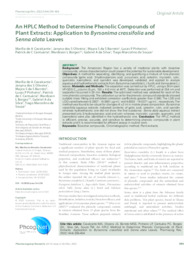An HPLC method to determine phenolic compounds of plant extracts: application to Byrsonima crassifolia and Senna alata leaves.
An HPLC method to determine phenolic compounds of plant extracts: application to Byrsonima crassifolia and Senna alata leaves.
Author(s): CAVALCANTE, M. de A.; OLIVEIRA, J. dos S.; BARRETO, M. S. da S.; PINHEIRO, L. P.; CANTUÁRIA, P. de C.; BORGES, W. L.; SILVA, G. A. da; SOUZA, T. M. de
Summary: Background: The Amazonian Region has a variety of medicinal plants with bioactive compounds, whose characterization could present the potential for sustainable development. Objectives: A method for separating, identifying, and quantifying a mixture of nine phenolic compounds (gallic acid, 3-hydroxybenzoic acid, p-coumaric acid, catechin, myricetin, rutin, quercetin, kaempferol, and cyanidin) was developed, validated, and applied to analyze aqueous and hydroethanolic extracts from Byrsonima crassifolia (L.) Kunth and Senna alata (L.) leaves. Materials and Methods: The separation was carried out by HPLC, using a Shim-pack VP-ODS C18 column (5 μm, 150 x 4.6 mm) at 40°C. Detection was performed at 254 nm and separation occurred in 35 min. Results: The optimized method was validated for each of the nine phenolic compounds. The calibration curve for the phenolic compound standards showed suitable linear fitting and exhibited correlation coefficients greater than 0.990. The LOD and LOQ varied between 6.2807 - 14.8851 μg mL-1 and 6.8002 - 16.0071 μg mL-1, respectively. The method was found to be robust for changes of ±2 ml in mobile phase composition. Byrsonima crassifolia aqueous extracts indicated contents of gallic acid, catechin, rutin, and cyanidin whereas hydroethanolic one did not show the first substance. Senna alata aqueous extract presented only 3-hydroxybenzoic acid and rutin whereas myricetin, cyanidin, quercetin, and kaempferol were also identified in the hydroethanolic one. Conclusion: The HPLC method is efficient, precise, accurate, and sensitive to determining phenolic compounds in plant extracts and it is recommended for efficient assays in routine work.
Publication year: 2022
Types of publication: Journal article
Unit: Embrapa Amapá
Observation
Some of Embrapa's publications are published as ePub files. To read them, use or download one of the following free software options to your computer or mobile device. Android: Google Play Books; IOS: iBooks; Windows and Linux: Calibre.
Access other publications
Access the Agricultural Research Database (BDPA) to consult Embrapa's full library collection and records.
Visit Embrapa Bookstore to purchase books and other publications sold by Embrapa.

